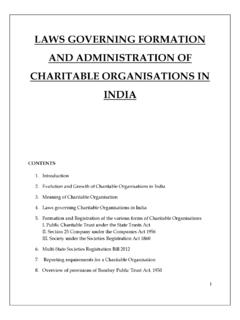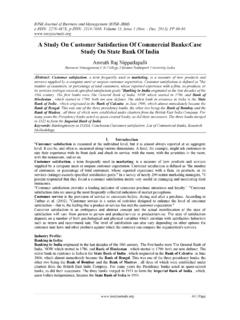Transcription of 098200 61049/09323061049 email id: …
1 AN OVERVIEW OF BANKING SECTOR IN INDIA CA. Rajkumar S. Adukia (Hons.), FCA, ACS, ACWA, , DIPR, DLL & LP, MBA, IFRS(UK) 098200 61049/09323061049 email id: Website: To download information on various subjects visit To receive regular updates kindly send test email to Introduction A bank is a financial institution and a financial intermediary that accepts deposits and channels those deposits into lending activities, either directly or through capital markets. A bank connects customers that have capital deficits to customers with capital surpluses. Due to their critical status within the financial system and the economy generally, banks are highly regulated in most countries. They are generally subject to minimum capital requirements which are based on an international set of capital standards, known as the Basel Accords. Banking in India originated in the last decades of the 18th century.
2 The first banks were The General bank of India, which started in 1786, and bank of Hindustan, which started in 1790; both are now defunct. The oldest bank in existence in India is the State bank of India, which originated in the bank of Calcutta in June 1806, which almost immediately became the bank of Bengal. This was one of the three presidency banks, the other two being the bank of Bombay and the bank of Madras, all three of which were established under charters from the British East India Company. For many years the Presidency banks acted as quasi-central banks, as did their successors. The three banks merged in 1921 to form the Imperial bank of India, which, upon India's independence, became the State bank of India in 1955. Structure of Indian Banking As per Section 5(b) of the Banking Regulation Act 1949: Banking means the accepting, for the purpose of lending or investment, of deposits of money from the public, repayable on demand or otherwise, and withdawal by cheque, draft, order or otherwise.
3 All banks which are included in the Second Schedule to the Reserve bank of India Act, 1934 are scheduled banks. These banks comprise Scheduled Commercial Banks and Scheduled Cooperative Banks. Scheduled Commercial Banks in India are categorised into five different groups according to their ownership and / or nature of operation. These bank groups are: (i) State bank of India and its Associates, (ii) Nationalised Banks, (iii) Regional Rural Banks, (iv) Foreign Banks and (v) Other Indian Scheduled Commercial Banks (in the private sector). Besides the Nationalized banks (majority equity holding is with the Government), the State bank of India (SBI) (majority equity holding being with the Reserve bank of India) and the associate banks of SBI (majority holding being with State bank of India), the commercial banks comprise foreign and Indian private banks. While the State bank of India and its associates, nationalized banks and Regional Rural Banks are constituted under respective enactments of the Parliament, the private sector banks are banking companies as defined in the Banking Regulation Act.
4 These banks, along with regional rural banks, constitute the public sector (state owned) banking system in India. The Public Sector Banks in India are back bone of the Indian financial system. The cooperative credit institutions are broadly classified into urban credit cooperatives and rural credit cooperatives. Scheduled Co-operative Banks consist of Scheduled State Co-operative Banks and Scheduled Urban Co-operative Banks. Regional Rural Banks (RRB s) are state sponsored, regionally based and rural oriented commercial banks. The Government of India promulgated the Regional Rural Banks Ordinance on 26th September 1975, which was later replaced by the Regional Rural bank Act 1976. The preamble to the Act states the objective to develop rural economy by providing credit and facilities for the development of agriculture, trade, commerce, industry and other productive activities in the rural areas, particularly to small and marginal farmers, agricultural labourers, artisans and small entrepreneurs.
5 bank Nationalization The Government of India issued an ordinance and nationalised the 14 largest commercial banks with effect from the midnight of July 19, 1969. Within two weeks of the issue of the ordinance, the Parliament passed the Banking Companies (Acquisition and Transfer of Undertaking) Bill, and it received the presidential approval on 9 August 1969. The need for the nationalisation was felt mainly because private commercial banks were not fulfilling the social and developmental goals of banking which are so essential for any industrialising country. Despite the enactment of the Banking Regulation Act in 1949 and the nationalisation of the largest bank , the State bank of India, in 1955, the expansion of commercial banking had largely excluded rural areas and small-scale borrowers. A second dose of nationalization of 6 more commercial banks followed in 1980. The stated reason for the nationalization was to give the government more control of credit delivery.
6 With the second dose of nationalization, the Government of India controlled around 91% of the banking business of India. Later on, in the year 1993, the government merged New bank of India with Punjab National bank . It was the only merger between nationalized banks and resulted in the reduction of the number of nationalised banks from 20 to 19. After this, until the 1990s, the nationalised banks grew at a pace of around 4%, closer to the average growth rate of the Indian economy. List of Nationalised Banks in India in 2012: 1. Allahabad bank 2. Andhra bank 3. bank of Baroda 4. bank of India 5. bank of Maharashtra 6. canara bank 7. Central bank of India 8. Corporation bank 9. Dena bank 10. Indian bank 11. Indian Overseas bank 12. Oriental bank of Commerce 13. Punjab and Sind bank 14. Punjab National bank 15. State bank of Bikaner & Jaipur 16. State bank of Hyderabad 17.
7 State bank of India (SBI) 18. State bank of Indore 19. State bank of Mysore 20. State bank of Patiala 21. State bank of Travancore 22. Syndicate bank 23. UCO bank 24. Union bank of India 25. United bank of India 26. Vijaya bank Reserve bank of India has, vide its letter no DBOD. BP. 1630 dated April 15, 2005 confirmed that IDBI Ltd. (since renamed as IDBI bank Ltd.) may be considered as Government-owned bank . Ministry of Finance has vide its circular no. 7/96/2005-BOA dated December 31, 2007 advised Secretaries of all Ministries/Departments of Government of India that IDBI bank Ltd. is to be treated on PAR with Nationalised Banks/State bank of India by Govt. Departments/Public Sector Undertakings/other entities for all purposes, including deposits/bonds/investments/guarantees etc. and Government business. Reserve bank of India The Reserve bank of India is the central bank of the country.
8 Central banks are a relatively recent innovation and most central banks, as we know them today, were established around the early twentieth century. The Reserve bank of India was set up on the basis of the recommendations of the Hilton Young Commission. The Reserve bank of India Act, 1934 (II of 1934) provides the statutory basis of the functioning of the bank , which commenced operations on April 1, 1935. The bank was constituted to Regulate the issue of banknotes Maintain reserves with a view to securing monetary stability and To operate the credit and currency system of the country to its advantage. The bank began its operations by taking over from the Government the functions so far being performed by the Controller of Currency and from the Imperial bank of India, the management of Government accounts and public debt. The existing currency offices at Calcutta, Bombay, Madras, Rangoon, Karachi, Lahore and Cawnpore (Kanpur) became branches of the Issue Department.
9 Offices of the Banking Department were established in Calcutta, Bombay, Madras, Delhi and Rangoon. Burma (Myanmar) seceded from the Indian Union in 1937 but the Reserve bank continued to act as the Central bank for Burma till Japanese Occupation of Burma and later upto April, 1947. After the partition of India, the Reserve bank served as the central bank of Pakistan upto June 1948 when the State bank of Pakistan commenced operations. The bank , which was originally set up as a shareholder's bank , was nationalised in 1949. The Reserve bank of India was nationalised with effect from 1st January, 1949 on the basis of the Reserve bank of India (Transfer to Public Ownership) Act, 1948. All shares in the capital of the bank were deemed transferred to the Central Government on payment of a suitable compensation. An interesting feature of the Reserve bank of India was that at its very inception, the bank was seen as playing a special role in the context of development, especially Agriculture.
10 When India commenced its plan endeavours, the development role of the bank came into focus, especially in the sixties when the Reserve bank , in many ways, pioneered the concept and practise of using finance to catalyse development. The bank was also instrumental in institutional development and helped set up insitutions like the Deposit Insurance and Credit Guarantee Corporation of India, the Unit Trust of India, the Industrial Development bank of India, the National bank of Agriculture and Rural Development, the Discount and Finance House of India etc. to build the financial infrastructure of the country. With liberalisation, the bank 's focus shifted back to core central banking functions like Monetary Policy, bank Supervision and Regulation, and Overseeing the Payments System and onto developing the financial markets. Regulation of Banks by RBI The Reserve bank of India has been empowered under the Banking Regulation Act, 1949 to regulate and supervise banks' activities in India and their branches abroad.












